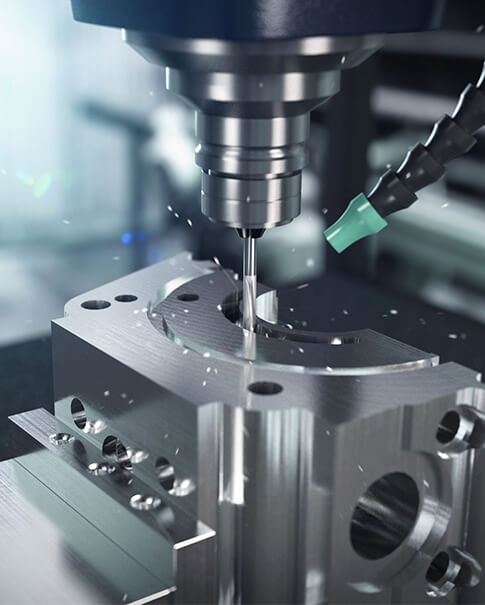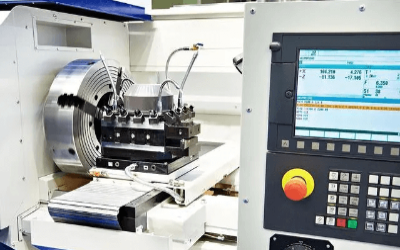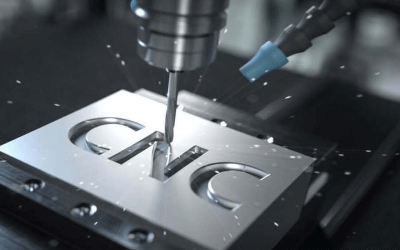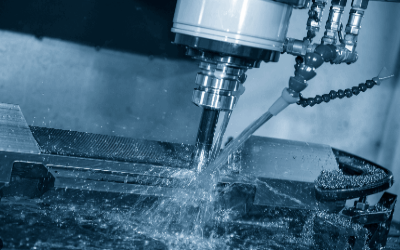
|
What Does CNC Mean?
Have you ever wondered, “What does CNC stand for?” CNC machining, or CNC manufacturing, is a process using computer numerical control (CNC) machines, which are tools such as mills and lathes guided by computer instructions that control the precision of the instruments.
|
 |
 |
What is CNC machining?
CNC stands for "Computer Numerical Control" and CNC machining is defined as a subtractive manufacturing process, usually using computer controls and machine tools, to produce custom-designed parts. This is a fundamentally different way of manufacturing compared to additive (3D printing) or formative (Injection Molding) technologies. The material removal mechanisms have significant implications on the benefits, limitations and design restrictions of CNC.
CNC machining is a digital manufacturing technology: it produces high-accuracy parts with excellent physical properties directly from a CAD file. Due to the high level of automation, CNC is price-competitive for both one-off custom parts and medium-volume productions.
|
CNC Machining Process:
CNC machining is a manufacturing process that utilizes computer controls to operate and manipulate machines and cutting tools to shape raw materials, such as metal, plastic, wood, foam, composites, etc., to produce custom parts.
CNC machining process and operations include the following stages:
Design CAD models
Convert CAD files to CNC programs
Equipped with CNC machine or CNC machining center
Execute machining operation instructions.
Types of CNC machines
The earliest numerical control machines date to the 1940s when motors were first employed to control the movement of pre-existing tools. As technologies advanced, the mechanisms were enhanced with analog computers, and ultimately with digital computers, leading to the rise of CNC machining.
The vast majority of today’s CNC arsenals are completely electronic. Some of the more common CNC-operated processes include ultrasonic welding, hole-punching and laser cutting. The most frequently used machines in CNC systems include the following:
|
CNC Mills
CNC mills are capable of running on programs comprised of number- and letter-based prompts that guide pieces across various distances. The programming employed for a mill machine could be based on either G-code or some unique language developed by a manufacturing team. Basic mills consist of a three-axis system (X, Y and Z), though most newer mills can accommodate three additional axes. |
 |
3-axis CNC milling machines are very common, as they can be used to produce most common geometries. They are relatively easy to program and operate, so start-up machining costs are relatively low.
Tool access can be a design restriction in CNC milling. As there are only three axes to work with, certain areas might be impossible to reach. This is not a big issue if the workpiece needs to be rotated just once, but if multiple rotations are needed the labor and machining costs increase fast.
5 axis CNC machining describes a numerically-controlled computerized manufacturing system that adds to the traditional machine tool’s 3-axis linear motions (X, Y, Z) two rotational axes to provide the machine tool access to five out of six part sides in a single operation. By adding a tilting, rotating work holding fixture (or trunnion) to the work table, the mill becomes what is called a 3+2, or an indexed or positional, machine, enabling the milling cutter to approach five out of six sides of a prismatic workpiece at 90° without an operator having to reset the workpiece.
It is not quite a 5-axis mill, however, because the fourth and fifth axes do not move during machining operations. Adding servomotors to the additional axes, plus the computerized control for them – the CNC part –would make it one. Such a machine- which is capable of full simultaneous contouring- is sometimes called a “continuous” or “simultaneous” 5-axis CNC mill. The two additional axes can also be incorporated at the machining head, or split – one axis on the table and one on the head.
|
|
CNC turning (lathes)
The workpiece is held on the spindle while rotating at high speed. A cutting tool or center drill traces the outer or inner perimeter of the part, forming the geometry. The tool does not rotate and moves along polar directions (radially and lengthwise). CNC lathe machine in action. |
CNC lathes are extensively used, because they can produce parts at a much higher rate and at a lower cost per unit than CNC mills. This is especially relevant for larger volumes.
The main design restriction of CNC lathes is that they can only produce parts with a cylindrical profile (think screws or washers). To overcome this limitation, features of the part are often CNC milled in a separate machining step. Alternatively, 5-axis mill-turning CNC centers can be used to produce the same geometry in one step.
Electric Discharge Machines
Electric-discharge machining (EDM) — alternately referred to as die sinking and spark machining — is a process that molds workpieces into particular shapes with electrical sparks. With EDM, current discharges occur between two electrodes, and this removes sections of a given workpiece.
When the space between the electrodes becomes smaller, the electric field becomes more intense and thus stronger than the dielectric. This makes it possible for a current to pass between the two electrodes. Consequently, portions of a workpiece are removed by each electrode. Subtypes of EDM include:
Wire EDM: Wire EDM uses spark erosion to remove portions from an electronically conductive material.
Sinker EDM: Sinker EDM utilizes an electrode and workpiece soaked in dielectric fluid for the purpose of piece formation.
In a process known as flushing, debris from each finished workpiece is carried away by a liquid dielectric, which appears once the current between the two electrodes has stopped and is meant to eliminate any further electric charges.
Water Jet Cutters
In CNC machining, water jets are tools that cut hard materials, such as granite and metal, with high-pressure applications of water. In some cases, the water is mixed with sand or some other strong abrasive substance. Companies often shape factory machine parts through this process.
Water jets are employed as a cooler alternative for materials that are unable to bear the heat-intensive processes of other CNC machines. Due to their cooler nature, several sectors like the aerospace and mining industries rely on water jets, where they use them for carving and cutting, among other functions. Companies also use water jet cutters for applications requiring very intricate cuts in material, as the lack of heat prevents any change in the material’s intrinsic properties that may result from metal on metal cutting.
CNC Machining Materials
The CNC machining process is suitable for a variety of engineering materials, including:
Metal (e.g., aluminum, brass, stainless steel, alloy steel, etc.)
Plastic (e.g., PEEK, PTFE, nylon, etc.)
Wood
Foam
Composites
The optimal material for selection to apply to a CNC manufacturing application is largely dependent on the particular manufacturing application and its specifications. Most materials can be machined provided that they can withstand the machining process—i.e., have sufficient hardness, tensile strength, shear strength, and chemical and temperature resistance.
The workpiece material and its physical properties are used to determine the optimal cutting speed, cutting feed rate, and depth of cut. Measured in surface feet per minute, the cutting speed refers to how fast the machine tool cuts into or removes material from the workpiece. The feed rate—measured in inches per minute—is a measure of how fast the workpiece is fed towards the machine tool, and the cut depth is how deep the cutting tool cuts into the workpiece. Typically, the workpiece will first undergo an initial phase in which it is roughly machined to the approximate, custom-designed shape and dimensions, and then undertake a finishing phase in which it experiences slower feed rates and shallower cut depths to achieve its more precise and accurate specifications.
Applications of CNC machining
One of the greatest things about CNC machining is the wide range of applications it has found over the years.
Here, we collected some recent examples to illustrate how professionals have exploited the benefits of CNC machining to get the best results in different industrial situations. Use them as inspiration for your projects.
Aerospace
Aerospace was one of the first industries to use CNC machining. This is due to its ability to manufacture lightweight parts with excellent physical properties and very tight tolerances. CNC machining is used both for aircraft parts and also during the development stages.
Automotive
CNC machining has applications in the automotive industry when manufacturing of high-performance custom parts is required.
Electrical
CNC machining also helps in the prototyping and production of consumer electronics. These electronics include laptops, smartphones, and many others. The chassis of an Apple MacBook, for example, comes from the CNC machining of extruded aluminum and then anodized.
Medical
CNC machining offers its use on various medically safe materials. Since the process is suited to one-off custom parts, it has many applications in the medical industry. The tight tolerances afforded by CNC machining are essential to the high performance of machined medical components.
Commuication Equipment
Communications companies rely on premium quality parts in their equipment design. Inferior quality can cause equipment failure, leading to interrupted calls, poor video transmission, and satellite broadcast blackouts.CNC machining is one of the best ways to ensure precisely manufactured telecommunications equipment. The computer technology allows for the design and production of intricate specialty parts. CNC machinists have access to a number of innovative machining techniques that let them produce even the most complex parts.
Robotics
Dimensional accuracy is vital in robotics. Robots often work between fixed points in space and can’t accept large deviations in dimensional accuracy. At GT, we offer CNC Machining to a standard tolerance of ±0.05mm, and higher tolerances on request. This is crucial for applications that demand precise and highly repeatable movements.
CNC Machining allows for the surface finish to be controlled precisely. In many robotic cases where gripping or suction is required, part flatness and surface roughness are critical properties. CNC Machining can produce parts to a surface roughness of Ra 0.8μm and even lower with additional finishing processes.
Final Words
CNC milling is an immensely efficient process that helps remove material from a workpiece with varying geometrical intricacies. Therefore, you must carefully make a purchasing decision based on your requirements, budget, and work hours.
Most small machine factories do not have to work on intricate geometrical patterns; therefore, a 3-axis machine gets the job done for them. For specialized applications such as working on complex geometries, machinists must purchase a 4-axis machine. If you require ultimate precision in your machined parts and are working on complex and tilted geometries, a 5-axis machine is the one for you.
Do you think of making use of one of the three processes in your project? Why not try us at GT? GT specialized in CNC machining and rapid protyping for 13 years ,Which is a high quality CNC machining service provider in China,Provide high quality 5 - axis processing services. Our expert team is highly knowledgeable in CNC machining, and we can guarantee high-quality products tailored to your requirements. Get in touch with a member of the GT team or upload a quote via the link below. We're at your service!